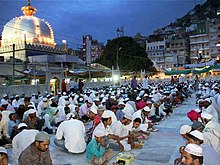
| Part of a series on Islam Sufism |
|---|
 |
| Ideas |
| Practices |
Sufi orders
|
| List of sufis |
| Topics in Sufism |
|
|
Langar (Persian: لنگر) is an institution among Sufi Muslims in South Asia whereby food and drink are given to the needy regardless of social or religious background. Its origins in Sufism are tied to the Chishti Order.
Etymology
Langar is originally a Persian word, and later came into Urdu and Punjabi from it, and in Bengali as longor (Bengali: লঙ্গর).
History
Langar, the practice and institution, was first started by Baba Farid, a Muslim of the Chishti Sufi order. The institution of the langar was already popular in the 12th and 13th century among Sufis of the Indian subcontinent. The practice grew and is documented in the Jawahir al-Faridi compiled in 1623 CE. It was later, both the institution and term, adopted by Sikhs.
The food is served out of a massive pot called a deg in the precincts of a dargah (Sufi shrine).
Religious meaning
Serving food to the needy has been a rich tradition among Sufis, especially of the Chishti Order.
There is extensive use of free food imagery and metaphor in Sufi writings. Sugar and other sweet foods represent the sweetness of piety and community with God, while salt symbolizes purity and incorruptibility. The transformation of the raw wheat to finished bread is used as an analogy for Sufi spiritual development.
Sufi ritual observances (dhikr) are concerned with remembrance of God through exaltation and praise. Singing, dancing, and drumming are commonly part of such rituals, as is sharing of food. The tradition of langar was also adopted by the Sikh community, where it goes by the same name.
Langar khana
Langar is distributed to all in a langar khana (lit. 'Alms-house'). In a large dargah there are two degs (cauldrons for cooking food) on either side of the saham chiragh (courtyard lamp) fixed into solid masonry in which a palatable mixture of rice, sugar, ghee (butter) and dried fruits is cooked for distribution to the public as tabarruk. The circumference at the edge of the larger cauldron is 3.1 metres (10+1⁄4 ft). It cooks 70 mounds of rice, while the smaller deg takes 28 mounds. In the dergah at Ajmer, one of them was presented by Emperor Akbar in 1567 CE. The princes or the well-to-do pilgrims order these degs to be cooked generally during the Urs period.
The langar khana at Ajmer
Bari Deg: Inside the Sahan-e-Chiragh and on the right side of Buland Darwaza is located Bari Deg. Emperor Akbar pledged to visit Ajmer Sharif on foot and presented a large cauldron if victorious in Chittaurgarh battle. So he kept his words after winning the battle. The circumference of the cauldron (Deg) is 11.4 metres (12+1⁄2 yd) and 125 mounds of rice can be cooked in it at a time. It was presented in AH 976 (1568/1569 CE).
Chhoti Deg: It is located on the left side of Buland Darwaza inside Sahan-e-Chiragh. It was presented by Sultan Nooruddin Jahangir in AH 1013 (1604/1605). Eighty mounds of rice can be cooked in it at a time.
References
- Kathleen Seidel, Serving Love, Serving the Guest: A Sufi Cookbook, September 2000. Accessed 15 January 2010.
- Satish C. Bhatnagar (November 2012), My Hindu Faith and Periscope, Volume 1, Trafford, p. 245, ISBN 9781466960978
- Steingass, Francis Joseph (1992), A Comprehensive Persian-English Dictionary, Asian Educational Services, p. 1130, ISBN 9788120606708
- Epilogue, Vol 4, Issue 1, p. 45
- Talib, Gurbachan Singh (1973), Baba Sheikh Farid: His Life and Teaching, p. 7
- Barbara D Metcalf (1984). Moral Conduct and Authority: The Place of Adab in South Asian Islam. University of California Press. pp. 336–339. ISBN 978-0-520-04660-3.
- ^ R. Nivas (1967), Transactions, Volume 4, The word langar, and this institution has been borrowed, so to speak, from the Sufis. The khanqas of the Chisti and other Sufi saints had a langar open to the poor and the rich, though the Hindus mostly kept away from them. To make the Brahmin sit with the pariah and do away with untouch- ability, and to make the Hindus and Muslims eat from the same kitchen and destroy all social, Indian Institute of Advanced Study, p. 190
- Kathleen Seidel, Serving Love, Serving the Guest: A Sufi Cookbook, September 2000. Accessed 15 January 2010.
- Lizzio, Kenneth (2005). "Pilgrims of Love: An Ethnography of a Global Sufi Cult". The Muslim World. 95 (4): 604–608. doi:10.1111/j.1478-1913.2005.00115.x.
- The Deghs (Cauldrons)& Lainger Dargah of Khawaja Gharib Nawaz Ajmer Sharif, Rajasthan, India HAZRAT KHWAJA GARIB NAWAZ - Ajmer, Rajasthan, India